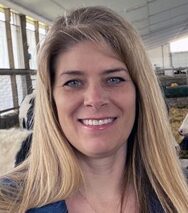 By Sara Wood, Director, Ontario Federation of Agriculture Fall means harvest for most farmers – and for members of the Ontario Federation of Agriculture (OFA), it also means the start of what we often call meeting season. The business of our farm organizations is year-round, but events and meetings for farmers or that need farmer involvement most often take place in fall and winter when we’re least busy with activities on the farm. At OFA, our organization’s annual general meeting is happening at RBC Place London in late November, which means our county and regional federations are gathering now to elect the delegates that they will be sending to that convention. At the same time, they’re deciding who their local representatives will be to the Policy Advisory Council (PAC), which was formed around 2007 as a way for local federation members to provide direct input to the 18-member provincial board that leads the OFA. Many OFA members aren’t as familiar with PAC and what it does as they are with the provincial board, yet PAC is arguably one of the most important assets OFA has when it comes to getting guidance from grassroots farmers on the issues, priorities, and directions the organization should be focusing on. PAC currently has 90 members who represent local or regional federations of agriculture and farm commodities and meets multiple times a year to discuss current issues, bring up farmer concerns and help the board shape policy. PAC has certainly been an invaluable process for me. I first became involved with the provincial organization when they invited young leaders to attend an event at Queens Park along with the provincial directors. I had wanted to become a more active member and being part of PAC was a good way to learn more about agriculture in other parts of the province and find different solutions to challenges we were facing locally. It directly contributed to my decision to join the provincial board last year and I now sit on the PAC Steering Committee, which provides guidance and leadership to PAC. The most important aspect of PAC, though, is that input from its members matters and really does make a difference. PAC, for example, was instrumental in helping OFA update and shape its land use policy last year and provided valuable feedback on what key elements farmers would like to see in the next federal-provincial agricultural policy framework, currently in development. Several years ago, OFA developed a guidebook on agriculture and rural issues for municipal councils and their staff. A review of this publication by PAC led to many valuable updates that helped make the resource more useful. And it was feedback from PAC in particular that made it clear that the farm community desperately needed more mental health supports, which ultimately resulted in the recently launched Farmer Wellness Initiative that offers free counselling services to farmers and their families 24 hours a day, 365 days a year. As with anything, however, there are always ways to do things better and PAC is no different. Dairy farmer Julie Danen is part of the PAC Steering Committee. In addition to its current activities, she sees a stronger role for PAC as a training ground for future OFA provincial board members. “The benefits of training and improving the strengths of PAC delegates can be far-reaching, whether they’re using this new knowledge with their local boards or becoming part of the OFA board in the future,” says Danen. “PAC is about discussing policy and bringing new ideas about policy to the OFA board and having strong PAC members that can move into director positions in the future will improve what that can do.” Patrick Verkley raises broiler chickens and grows grain and oilseed crops in Middlesex County and is also a member of the PAC Steering Committee. He believes strongly in the need for PAC to provide value to the organization and sees it as a way to help prepare OFA for future challenges and issues. “PAC’s role is to bring a diversity of experience and knowledge to help aid in the OFA board’s decision-making process,” he says. “Where PAC can play a larger role is in blue-sky thinking and helping to identify the next emerging issues that OFA and farmers will need to deal with – what could we be facing five years from now, for example? These types of discussions are valuable today and in the long run.” At the end of the day, grassroots input into OFA matters. Your thoughts and ideas are valuable and if you’d like to take a more active role in shaping the activities of our organization, please consider letting your name stand to become a member of our Policy Advisory Council. It can be your chance to make a difference in the future of farming in Ontario. For more information, contact: Tyler Brooks Director of Communications and Stakeholder Relations Ontario Federation of Agriculture 519-821-8883 ext. 218 [email protected]
0 Comments
OFA appreciates initial government enhancements to business risk management programs for farmers9/20/2022  By Mark Reusser, Vice President, Ontario Federation of Agriculture Farming can be full of unexpected crises, from market volatility and crop losses due to bad weather to tragedies like barn fires. Having security and stability to ensure Ontario farmers remain profitable and protected is vital to the viability of the farming industry and the Ontario economy. After all, agriculture in Ontario supports 860,400 jobs and contributes over $47 billion to the economy annually. Cue Business Risk Management programs – tools to provide farmers with protection against income and production losses and help them manage risks beyond their control that threaten the financial sustainability of farms. Earlier this summer, the Ontario Federation of Agriculture (OFA) was pleased with the announcement at the Federal-Provincial-Territorial Ministers of Agriculture meeting in Saskatoon that enhancements are being made to improve federal and provincial Business Risk Management programs. As a result of open communication and frequent conversations with federal and provincial officials, the ministers agreed to two significant improvements to the AgriStability program. In 2021 the Reference Margin Limitation provisions were removed from the AgriStability program, which increased the predictability of the program while also increasing the likelihood farmers trigger a payment and potentially receiving a larger payment. Earlier this year, ministers also agreed to increase the compensation rate for the AgriStability program from 70% to 80% for the 2022 program year. This means farmers who trigger a payment will receive a larger payout under the program moving forward. AgriStability protects farm businesses against large declines in farming income for market, production or economic reasons beyond their control. It is the only tool in the current suite of Business Risk Management programs that helps farmers manage both production and market risks. These include external, unpredictable challenges like weather, plant or animal diseases, transportation problems, trade issues, and geopolitical considerations like the Russian invasion of Ukraine can impact farm businesses. Along with the Canadian Federation of Agriculture (CFA), OFA had regularly been encouraging governments to strengthen their existing Business Risk Management programs to provide greater financial support to farmers who have experienced loss due to risks beyond their control. The recommendations and requests OFA made to government policymakers to improve the AgriStability program came as a direct result of feedback we received from our 38,000 farm business members across the province. We appreciate the effort and collaboration of government to recognize the needs of farmers and address them with program enhancements. There are currently three Business Risk Management programs available to farmers, and OFA has long been hearing farmer concerns and asking for program enhancements that would both boost coverage available for farm businesses and improve farmer participation rates by simplifying and streamlining program administration. In addition to the compensation rate change in the AgriStability program, OFA has also been asking for governments to restore the program’s payment trigger to 85% of a farmer’s historical reference margins. AgriInvest is a self-managed producer-government saving program designed to help farmers manage small income declines and make investments to manage risk and improve market income. For this program, the ask is for an increase in the basic maximum matched producer contribution rate to 1.5% of Allowable Net Sales and to establish a $100,000 annual maximum for matching contributions. AgriInsurance is a cost-shared program that stabilizes income by minimizing the economic effects of primary production losses caused by severe but uncontrollable natural hazards. OFA wants to ensure farmers in all provinces have greater access to adequate AgriInsurance coverage when they face short-term, multi-year consequences from weather-related disaster like drought or floods. The next federal-provincial agricultural policy framework will come into effect in 2023. OFA, along with CFA and other industry partners, will continue to work with the federal and provincial governments to secure additional financial and administrative improvements to these programs. By working together, we’ve been able to acknowledge and accommodate differences between provinces and commodities while recognizing the strengths that come from a united approach. Without a suite of fully funded Business Risk Management programs, Canadian farmers remain at a competitive disadvantage on the global market, and we look forward to continuing to build our relationship with governments to identify and address areas for program improvement. Food security plays an important role in overall national security, and it is critical that Ontario and Canada continue to protect and support our agriculture sector so that we never lose our ability to feed ourselves. For more information, contact: Tyler Brooks Director of Communications and Stakeholder Relations Ontario Federation of Agriculture 519-821-8883 ext. 218 [email protected]  By Jackie Kelly-Pemberton, Director, Ontario Federation of Agriculture Farmers more than most people have a very close relationship with the environment. We depend on air, soil, and water to grow our crops and raise our livestock, so we know first-hand how important it is to care for and nurture our natural ecosystems as best as we can. In fact, farmers are sometimes called the original environmentalists because of the many things we have long been doing to look after the land that is in our care – and the new practices we’re adopting on an ongoing basis as part of a long-term approach of continual improvement. My husband and I farm in Dundas County, south of Ottawa, where we grow crops and have a small beef herd. The environment has always been important on our farm, where we’ve planted cover crops to build soil health and minimize erosion and built fences to keep cattle out of our creeks and streams to protect water quality. We also actively participate in environmental research projects with universities, government, and industry partners to help in the search for sustainability and climate change solutions for farmers. I’m also involved with our local conservation area, supporting farmers and landowners in environmental practices that benefit soil and water quality, and helping to build awareness of the many stewardship activities happening on our farms. In agriculture, these environmental stewardship activities are called Best Management Practices (BMPs) and began as an initiative of Agriculture and Agri-Food Canada (AAFC) in 1992. BMPs are developed by government and industry experts using ongoing research and best available science, and help guide farmers on the best ways to approach everything from managing pests, controlling soil erosion and proper land drainage to nutrient management planning, no-till crop production and managing irrigation. The Ontario Federation of Agriculture (OFA) works in partnership with the Ontario Ministry of Agriculture, Food and Rural Affairs (OMAFRA) and AAFC on BMP development and to produce detailed guidebooks for farmers on how to implement those BMPs on farms across Ontario. Many BMPs have also been incorporated into the Environmental Farm Plan (EFP), a voluntary program launched by farm organizations with support from government in 1993 to help farmers assess where and how they can make environmental improvements on their farms. Over 40,000 people have participated in the EFP since its launch, which further highlights the strong commitment our sector has long had to continuous environmental improvement. BMP information is updated on a regular basis as science and environmental priorities evolve. The most recent change has been digitizing all the BMP resources to make them available online. Working with OMAFRA and AAFC, OFA led the development of a new website called BMPbooks.com, an online library of how-to guides for sustainable agriculture and rural living. With resources for environment, habitat, soils and water, the site is also searchable by the type of problem you’re wanting to solve on-farm and by crop or farm type or what to do in specialty situations, such as if you’re working with land that you’re renting from another landowner. BMPs are going to be of even greater importance for farmers as government policies designed to mitigate climate change impacts become more prominent. We’ve already seen the announcement earlier this year by the federal government of a 30 per cent nitrous oxide emissions reduction target for agriculture, for example. More and better use of on-farm best management practices that focus on improving fertilizer use is an excellent way for farmers to continue the environmental stewardship work they’ve already been doing voluntarily for decades. Reducing tillage, adopting precision technologies or planting cover crops are all examples of best management practice that can help manage and reduce synthetic fertilizer use on farm. Another example is an approach also recognized in source water protection called the 4Rs: applying the right fertilizer in the right amount to the right place at the right time. I encourage all farmers to visit bmpbooks.com and take a look at the wide range of digital resources that are now available. Additionally, most county and regional federation of agriculture offices also have printed copies available. For more information, contact: Tyler Brooks Director of Communications and Stakeholder Relations Ontario Federation of Agriculture 519-821-8883 ext. 218 [email protected]  By Tracey Arts, Director, Ontario Federation of Agriculture Without a doubt, it’s a busy time of year as many of us look ahead to harvesting the crops we’ve nurtured and tended to this growing season. As the days get shorter, kids go back to school, leaves start to change, nights get cooler – it’s evident that fall is upon us. Fall is the opportune time to celebrate the bounty that is Ontario agriculture, the hardworking individuals that produce our food and to reconnect. Ontario farmers grow and produce over 200 different commodities, with many fan favourites such as apples, squash, pears, sweetcorn and much more coming in season. As you make your pre-harvest to do list The Ontario Federation of Agriculture (OFA) encourages everyone to prioritize industry events, sourcing local and reconnecting with peers. It’s been a long two-years with cancelled events, pivots to virtual platforms and we’re greatly looking forward to re-connecting with our members in person this fall. After a two-year hiatus, Canada’s Outdoor Farm Show (COFS) and the International Plowing Match and Rural Expo (IPM) are making a much-anticipated return to in person exhibition. COFS is an annual highlight for our organization as we host OFA members, industry partners and fellow stakeholders inside Federation House. Our theme this year is ‘celebrating Ontario agriculture’ with local cider, coffee, and insulated grocery totes as complimentary giveaways to members. This year’s show runs September 13-15 with OFA Member Service Representatives and board members on site to connect with members on farming, issues, concerns, or shared highlights of the event. Our benefit partners Farm Life, Scotiabank, Better Farming, Cooperators and Farm & Food Care Ontario will also be exhibiting inside Federation House and are eager to connect with you. One lucky OFA member will win a YETI cooler filled with local food products from Oxford and Elgin counties. For me, COFS is a great way to reconnect with people you haven’t seen in years. People are coming from all over the province from all facets of the sector. I always find myself running into people I went to college with, industry reps and peers. It’s also filled with resources and the opportunity to see new technology, farm equipment, livestock information, demos, and crop plots. I find it especially valuable to learn about the new crop varieties that are more tolerant to extreme weather conditions. There is so much to see and do for the whole family. If you’re unable to make it to COFS, you can also find us at the 2022 IPM in Kemptville September 20-24. OFA staff and executive will be on site and look forward to chatting with members in the booth. A variety of displays will be set up promoting local food, farm safety, food literacy and OFA’s benefit program. Members will also be treated to complimentary popcorn, apples, and giveaways. For many in our industry COFS and the IPM have become family traditions where we schedule a day off the farm to visit with our suppliers, neighbours, and friends. You can also make sourcing local Ontario foods a family affair by making a yearly trip to the pumpkin patch and apple orchard for a day of pick-your-own. Every year my family goes pumpkin picking and we have so much fun selecting, decorating, and carving our pumpkins together. It’s a great time of year to source local, support local farmers and connect with the growers in your community. I encourage everyone reading to attend a fair, agricultural tradeshow, and source local this fall season. Make the time to re-connect with your food, peers, and your representatives at OFA. For more information, contact: Tyler Brooks Director of Communications and Stakeholder Relations Ontario Federation of Agriculture 519-821-8883 ext. 218 [email protected] |
Archives
May 2024
Categories |

 RSS Feed
RSS Feed
